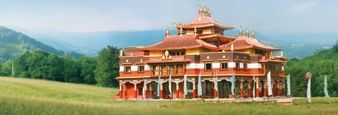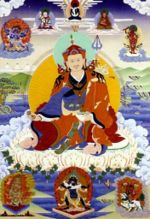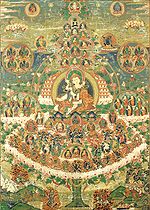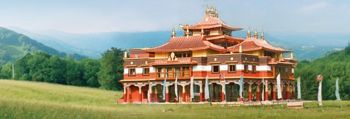Main Page: Difference between revisions
Jump to navigation
Jump to search
| (48 intermediate revisions by 7 users not shown) | |||
| Line 25: | Line 25: | ||
<!-- STRAPLINE IMMEDIATELY BELOW BANNER --> | <!-- STRAPLINE IMMEDIATELY BELOW BANNER --> | ||
{| style="width:100%; background:none; margin:-.8em 0 -.7em 0;" | {| style="width:100%; background:none; margin:-.8em 0 -.7em 0;" | ||
| style="font-size:95%; padding:10px 0; margin:0; text-align:left; white-space:nowrap; color:#000;" | [[Rigpa_Wiki:About|Overview | | style="font-size:95%; padding:10px 0; margin:0; text-align:left; white-space:nowrap; color:#000;" | [[Rigpa_Wiki:About|Overview]] '''·''' [[Search Help|Search]] '''·''' [[RigpaShedra:Policy|Policy]] '''·''' [[Help:Contents|Help]] | ||
| style="font-size:95%; padding:10px 0; margin:0; text-align:right; white-space:nowrap; color:#000;" | | | style="font-size:95%; padding:10px 0; margin:0; text-align:right; white-space:nowrap; color:#000;" | | ||
[[special:Recentchanges|Recent changes]] '''·''' [[Special:categories|Categories]] '''·''' [[Sitesupport-url| | [[special:Recentchanges|Recent changes]] '''·''' [[Special:categories|Categories]] '''·''' [[Sitesupport-url|Support Us]] '''·''' [[RigpaShedra:Acknowledgements|Acknowledgements]] | ||
|} | |} | ||
| Line 42: | Line 42: | ||
|- | |- | ||
| [[Image:Guru rinpoche.jpg|150px]] || style="background-color:#f7f7f7" cellpadding="5" | | | [[Image:Guru rinpoche.jpg|150px]] || style="background-color:#f7f7f7" cellpadding="5" | | ||
*'''[[Padmasambhava]]''' (Skt.), or '''Padmakara''' (Skt. ''Padmākara''; Tib. [[པདྨ་འབྱུང་གནས་]], ''Pemajungné''; [[Wyl.]] ''pad+ma 'byung gnas'') means ‘Lotus-Born’, which refers to Guru Rinpoche's birth from a lotus in the land of [[Oddiyana]]. '''Guru Rinpoche''', the ‘Precious Master’, is the founder of [[Tibetan Buddhism]] and the [[Buddha]] of our time. Whereas Buddha is known primarily for having taught the teachings of the [[sutra]] vehicle, Padmasambhava came into this world, and to Tibet in particular, in order to teach the [[tantra]]s. While [[Buddha Shakyamuni]] exemplifies the buddha principle, the most important element in the [[sutrayana]] path, Padmasambhava personifies the [[guru]] principle, the heart of [[Vajrayana]] Buddhism | *'''[[Padmasambhava]]''' (Skt.), or '''Padmakara''' (Skt. ''Padmākara''; Tib. [[པདྨ་འབྱུང་གནས་]], ''Pemajungné''; [[Wyl.]] ''pad+ma 'byung gnas'') means ‘Lotus-Born’, which refers to Guru Rinpoche's birth from a lotus in the land of [[Oddiyana]]. '''Guru Rinpoche''', the ‘Precious Master’, is the founder of [[Tibetan Buddhism]] and the [[Buddha]] of our time. Whereas Buddha is known primarily for having taught the teachings of the [[sutra]] vehicle, Padmasambhava came into this world, and to Tibet in particular, in order to teach the [[tantra]]s. While [[Buddha Shakyamuni]] exemplifies the buddha principle, the most important element in the [[sutrayana]] path, Padmasambhava personifies the [[guru]] principle, the heart of [[Vajrayana]] Buddhism... ([[Padmasambhava|Read more...]]) | ||
|- | |- | ||
|[[Image:LNNRefuge.jpg|150px]] | |[[Image:LNNRefuge.jpg|150px]] | ||
| Line 51: | Line 51: | ||
|[[Image:Shantideva.JPG|150px]] | |[[Image:Shantideva.JPG|150px]] | ||
| | | | ||
*'''[[Bodhicharyavatara]]''' (Skt. ''Bodhicaryāvatāra'') or '''Bodhisattvacharyavatara''' (Skt. ''Bodhisattvacaryāvatāra''; Tib. [[བྱང་ཆུབ་སེམས་དཔའི་སྤྱོད་པ་ལ་འཇུག་པ་]], [[Wyl.]] ''byang chub sems dpa'i spyod pa la 'jug pa'') or ''Introduction to the [[Bodhisattva]]'s Way of Life'' - [[Shantideva]]'s classic guide to the [[Mahayana]] path. [[Khenpo Namdrol]] said: Concerning the study of the ''Bodhicharyavatara'', my teacher [[Khenpo Tsöndrü]] told me that though the meaning of the text is not difficult to understand, applying the teachings to one’s mind is far more difficult. The purpose of the | *'''[[Bodhicharyavatara]]''' (Skt. ''Bodhicaryāvatāra'') or '''Bodhisattvacharyavatara''' (Skt. ''Bodhisattvacaryāvatāra''; Tib. [[བྱང་ཆུབ་སེམས་དཔའི་སྤྱོད་པ་ལ་འཇུག་པ་]], [[Wyl.]] ''byang chub sems dpa'i spyod pa la 'jug pa'') or ''Introduction to the [[Bodhisattva]]'s Way of Life'' - [[Shantideva]]'s classic guide to the [[Mahayana]] path. [[Khenpo Namdrol]] said: Concerning the study of the ''Bodhicharyavatara'', my teacher [[Khenpo Tsöndrü]] told me that though the meaning of the text is not difficult to understand, applying the teachings to one’s mind is far more difficult. The purpose of the Dharma is to transform the mind, to free us from our attachment to worldly concerns. Among all treatises and texts, Shantideva’s ''Bodhicharyavatara'' and Paltrul Rinpoche’s ''[[Words of My Perfect Teacher]]'' are the most powerful texts that serve this purpose. ([[Bodhicharyavatara|Read more...]]) | ||
|} | |} | ||
|width="5%" style="background-color:#ffffff"| | |width="5%" style="background-color:#ffffff"| | ||
| Line 57: | Line 57: | ||
[[Image:LerabLing.jpg|350px]] | [[Image:LerabLing.jpg|350px]] | ||
==Upcoming Events | ==Upcoming International Events== | ||
{| class="wikitable" style="color:black;background-color:#f4f4ff;" cellspacing="5" border="0" text-align:left,top" | {| class="wikitable" style="color:black;background-color:#f4f4ff;" cellspacing="5" border="0" text-align:left,top" | ||
|+ | |+ | ||
| Line 66: | Line 66: | ||
--> | --> | ||
|- | |- | ||
|valign="top"|<small> | |valign="top"|<small>8 Jan - 8 March. 2024</small> | ||
| | |Rigpa Shedra onsite and Online course of in-depth study of ''Introduction to the Middle Way ([[Madhyamakavatara]])'' with Khenpo Tashi Tseten. More information and registration [https://www.rigpashedra.org here] | ||
|} | |} | ||
==Audio Library== | ==Audio Library== | ||
| Line 87: | Line 84: | ||
|+ | |+ | ||
|- | |- | ||
|valign="top"|[[Image: | |valign="top"|[[Image:Rigpadotorg.png|92px]] | ||
|valign="top"|[[Image:LerabLing.jpg|338px]] | |valign="top"|[[Image:LerabLing.jpg|338px]] | ||
|valign="top"|[[Image:DzogchenBeara.jpg]] | |valign="top"|[[Image:DzogchenBeara.jpg]] | ||
|valign="top"|[[Image:SpiritualCareCentre.jpg]] | |valign="top"|[[Image:SpiritualCareCentre.jpg]] | ||
|- | |- | ||
|[http://www.rigpa.org '''Rigpa.org'''] | |[http://www.rigpa.org '''Rigpa.org'''] | ||
|[http://www.lerabling.org '''Lerab Ling'''] | |[http://www.lerabling.org '''Lerab Ling'''] | ||
|[http://www.dzogchenbeara.org '''Dzogchen Beara'''] | |[http://www.dzogchenbeara.org '''Dzogchen Beara'''] | ||
|[http://www. | |[http://www.dzogchenbeara.org/care-centre/ '''Spiritual Care Centre'''] | ||
|- | |- | ||
|} | |} | ||
| Line 115: | Line 110: | ||
* [http://www.rigpa.com.au/ Australia] | * [http://www.rigpa.com.au/ Australia] | ||
|width="150pt" valign="top"| | |width="150pt" valign="top"| | ||
* [http://www.rigpa.org/en/ | * [http://www.rigpa.org/en/about-rigpa/find-a-centre-near-you/country/262.html Austria] | ||
|width="150pt" valign="top"| | |width="150pt" valign="top"| | ||
* [http://www.rigpa. | * [http://www.rigpa-belgique.be/ Belgium] | ||
|width="150pt" valign="top"| | |width="150pt" valign="top"| | ||
* [http://www.rigpacanada.org/ Canada] | * [http://www.rigpacanada.org/ Canada] | ||
| Line 124: | Line 119: | ||
|- | |- | ||
|valign="top"| | |valign="top"| | ||
* [http:// | * [http://www.rigpa.org/en/about-rigpa/find-a-centre-near-you/country/266.html Czech Republic] | ||
|valign="top"| | |valign="top"| | ||
* [http://www.rigpa.org/en/courses-a-centres/find-a-centre-near-you/country/267.html Denmark] | * [http://www.rigpa.org/en/courses-a-centres/find-a-centre-near-you/country/267.html Denmark] | ||
|valign="top"| | |valign="top"| | ||
* [http://www.rigpa.org/en/ | * [http://www.rigpa.org/en/about-rigpa/find-a-centre-near-you/country/268.html/ Estonia] | ||
|valign="top"| | |valign="top"| | ||
* [http://www.rigpa.org/en/about-rigpa/find-a-centre-near-you/country/269.html/ Finland] | * [http://www.rigpa.org/en/about-rigpa/find-a-centre-near-you/country/269.html/ Finland] | ||
| Line 139: | Line 134: | ||
* [http://www.rigpa.nl/ Holland] | * [http://www.rigpa.nl/ Holland] | ||
|valign="top"| | |valign="top"| | ||
* [http://www.rigpa.org/en/ | * [http://www.rigpa.org/en/about-rigpa/find-a-centre-near-you/country/306.html/ India] | ||
|valign="top"| | |valign="top"| | ||
* [http://www.rigpa.ie/ Ireland] | * [http://www.rigpa.ie/ Ireland] | ||
| Line 150: | Line 145: | ||
* [http://www.rigpa.org/en/courses-a-centres/find-a-centre-near-you/country/299.html Japan] | * [http://www.rigpa.org/en/courses-a-centres/find-a-centre-near-you/country/299.html Japan] | ||
|valign="top"| | |valign="top"| | ||
* [http://www.rigpa.org/en/ | * [http://www.rigpa.org/en/about-rigpa/find-a-centre-near-you/country/300.html/ Norway] | ||
|valign="top"| | |valign="top"| | ||
* [ | * [https://www.rigpameditacion.org Spain] | ||
|valign="top"| | |valign="top"| | ||
* [http://www.rigpa.se/ Sweden] | * [http://www.rigpa.se/ Sweden] | ||
| Line 178: | Line 173: | ||
|- | |- | ||
|valign="top"| | |valign="top"| | ||
* [ | * [https://www.youtube.com/user/robertrigpa Rigpa Videos] | ||
|- | |- | ||
|valign="top"| | |valign="top"| | ||
| Line 191: | Line 183: | ||
|} | |} | ||
|} | |} | ||
[[Category: About Pages]] | |||
Latest revision as of 10:32, 21 February 2024
|
Welcome to the Rigpa Shedra Wiki,
an online encyclopedia of Tibetan Buddhism
We currently have 16,089 articles
|
|
| Overview · Search · Policy · Help |
Featured Pages
|
Upcoming International Events
Audio LibraryMore teachings...
|
Other Rigpa Sites

|

|

|

|
| Rigpa.org | Lerab Ling | Dzogchen Beara | Spiritual Care Centre |
National Rigpa Centres |
Study & Resources |





